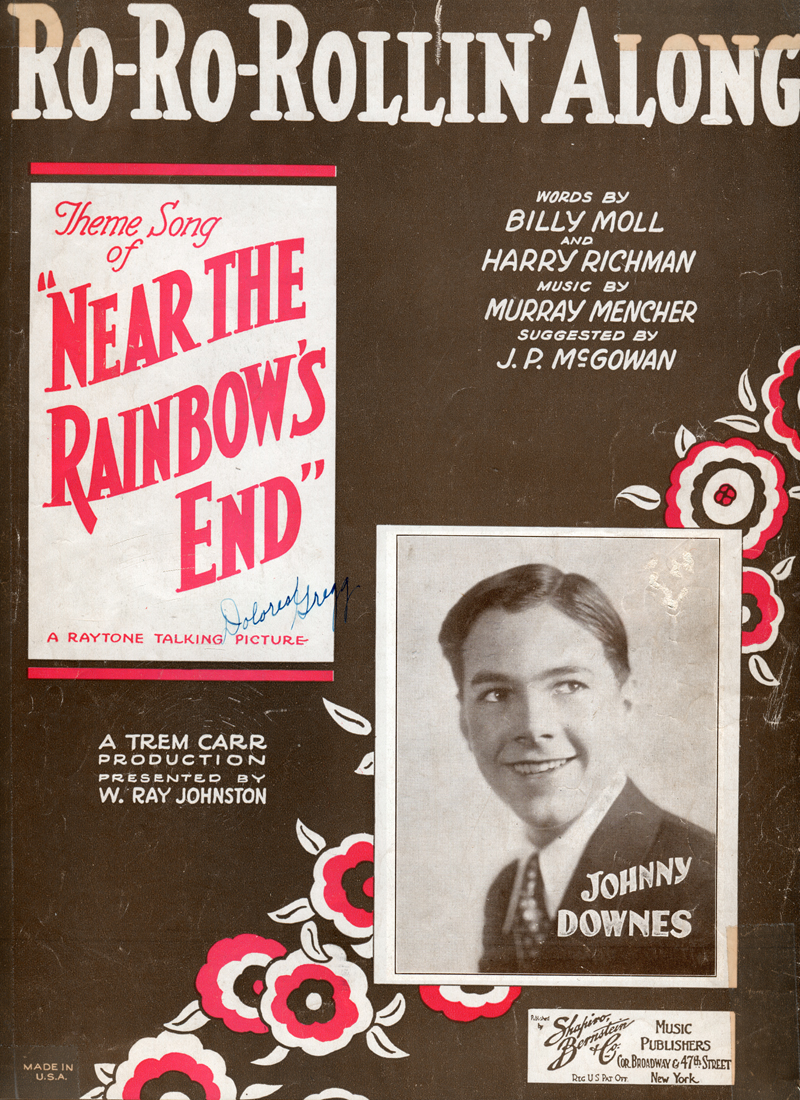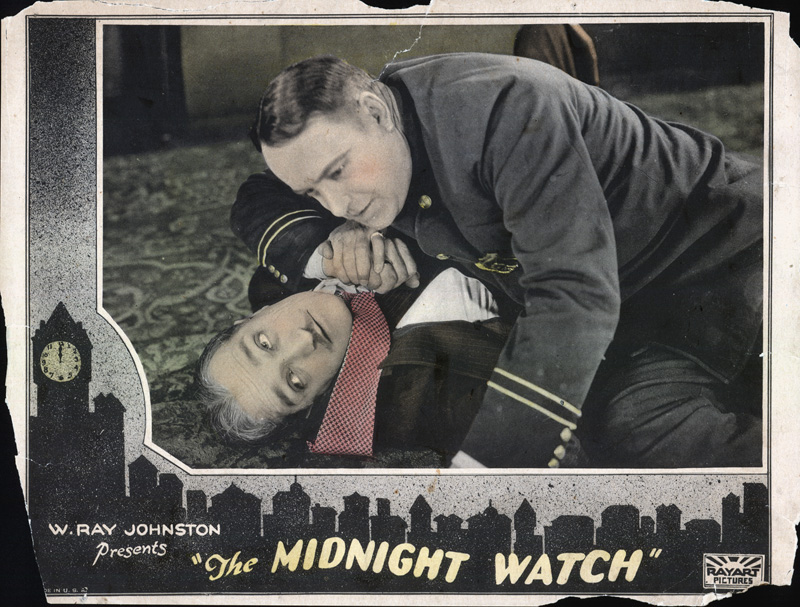|
|
"Ro-Ro-Rollin' Along" from
Trem Carr's "Near the Rainbow's End"
Shot in Placerita Canyon

Click image to enlarge
"Ro-Ro-Rollin' Along," theme song to "Near the Rainbow's End," a 1930 Trem Carr production of a Raytone (Ray Johnston) Talking Picture directed by J.P. McGowan, starring Bob Steele and shot in Placerita Canyon. Sheet music (©1930) published by Shapiro, Bernstein & Co. of New York. Song "suggested" (conceptualized/ordered) by McGowan; music by Murray Mencher; lyrics by Billy Moll and Harry Richman. Apparently the version of the song used in the film was performed by Johnny Downs (here spelled Downes), a child actor of the 1920s ("Our Gang") who pursued a vaudeville song-and-dance career before returning in the 1930s to Hollywood where he appeared in musicals. Carr was shooting "B"(udget) Westerns in Placerita Canyon by 1926 under his own name and in partnership with others. This film was released by Tiffany Productions, which had started in 1921. Tiffany took over the Reliance-Majestic Studios on Poverty Row in 1927 and distributed eight films starring Steele and 10 with Ken Maynard before going bankrupt in 1932 — a time when many small studios either disappeared or merged into Herbert Yates' Republic. Another little Poverty Row studio called Columbia Pictures bought Tiffany's studio complex. The year after they made this film, Carr and Johnston formed the first iteration of Monogram Pictures Corp. and leased property in Placerita Canyon for their own Western movie town — adding one more in a canyon where most of the ranches were already heavily used for filming. Carr's pal Ernie Hickson handled set decoration for "Near the Rainbow's End," which co-stars Lafe McKee, Al Ferguson, Alfred Hewston and Louise Lorraine. Stunts by Cliff Lyons (uncredited). About Bob Steele: About Bob Steele. Bob Steele was a big name in small Poverty Row pictures of the 1930s and '40s, landing lead roles in dozens of B-Westerns from the likes of Monogram and Republic. Born Robert Adrian Bradbury in Portland, Ore., on Jan. 23, 1907, Bob and his twin brother, Bill, toured with their vaudevillian parents as children. Their father, Robert N. Bradbury, came to Hollywood in the late 1910s and transitioned into film, first as an actor and then as a director. In 1920, the elder Bradbury first put his sons on the screen in "The Adventures of Bob and Bill," which was shot in Glendale, where the family lived. More often, Robert N. Bradbury shot in Placerita Canyon, which was dotted with movie ranches by the early 1920s. Bob Junior got his break in 1927 when, under contract with FBO, he landed the title role in "The Mojave Kid," directed by his father. Bob changed his name to Bob Steele for that film and stuck with it. Perhaps Steele's biggest contribution to the screen came vicariously in 1933 when he convinced his dad to cast one of his Glendale High School classmates, a budding actor named Marion Morrison, as the hero lawman in a series of films produced by Monogram's Paul Malvern under the "Lone Star Productions" label. Like Steele, his friend also changed his name — to John Wayne. Steele reached the height of his popularity during the 1930s with characters that drew on his physicality. His stardom diminished as he aged, but he didn't slow down. The 1940s saw Steele and some of his contemporaries like Johnny Mack Brown and Hoot Gibson churn out numerous B-Westerns for Monogram, frequently appearing together in pictures shot at Ernie Hickson's Monogram Ranch in Placerita Canyon. During the 1950s and beyond, Steele's old high school chum returned the favor that had been done two decades earlier. Steele landed bit parts in major John Wayne pictures including "Island in the Sky," "Rio Bravo" and "Rio Lobo." Steele made guest appearances in all of the popular television Westerns of the 1950s and '60s. He had a recurring role as Trooper Duffy in the 1965-67 comedic series, "F Troop," and closed out his film career in the early 1970s. He died at a hospital in Burbank on Dec. 21, 1988, following a long battle with emphysema. Further Reading: Melody Ranch: Movie Magic in Placerita Canyon |
SEE ALSO:
1928
Code of the West
(Newhall 1929)
1932
1934
Embossed Envelope 1932
Trem Carr, W. Ray Johnston 1934 ("Lost in the Stratosphere")
The Midnight Watch 1927
Ridin' Luck 1927
Prince of the Plains 1927
Gun-Hand Garrison 1927
Isle of Lost Men 1928
Code of the West 1929
Shanghai Rose 1929
Near the Rainbow's End 1930
God's Country and The Man 1931
Sunrise Trail 1931
South of Santa Fe 1932
The Return of Casey Jones 1932
Happy Landing 1934
Non-SCV 1930
Full Movie
|
The site owner makes no assertions as to ownership of any original copyrights to digitized images. However, these images are intended for Personal or Research use only. Any other kind of use, including but not limited to commercial or scholarly publication in any medium or format, public exhibition, or use online or in a web site, may be subject to additional restrictions including but not limited to the copyrights held by parties other than the site owner. USERS ARE SOLELY RESPONSIBLE for determining the existence of such rights and for obtaining any permissions and/or paying associated fees necessary for the proposed use.




















